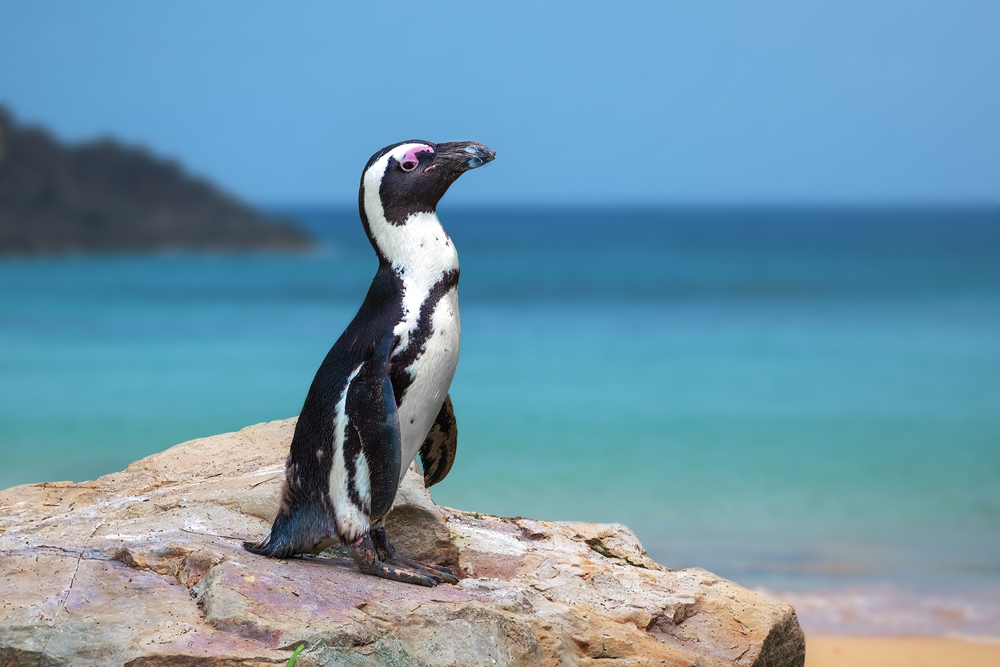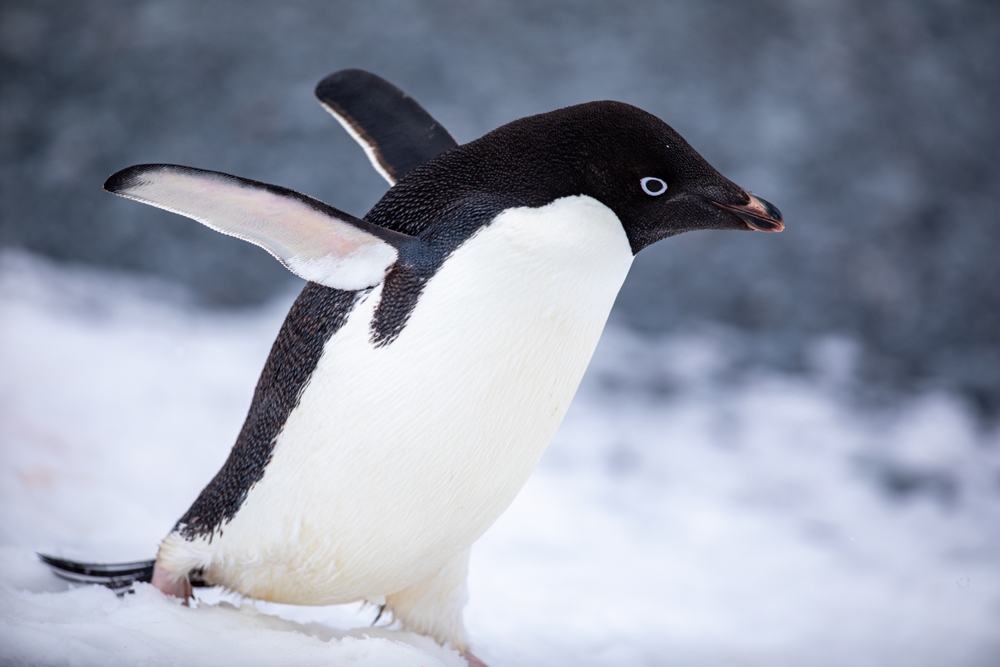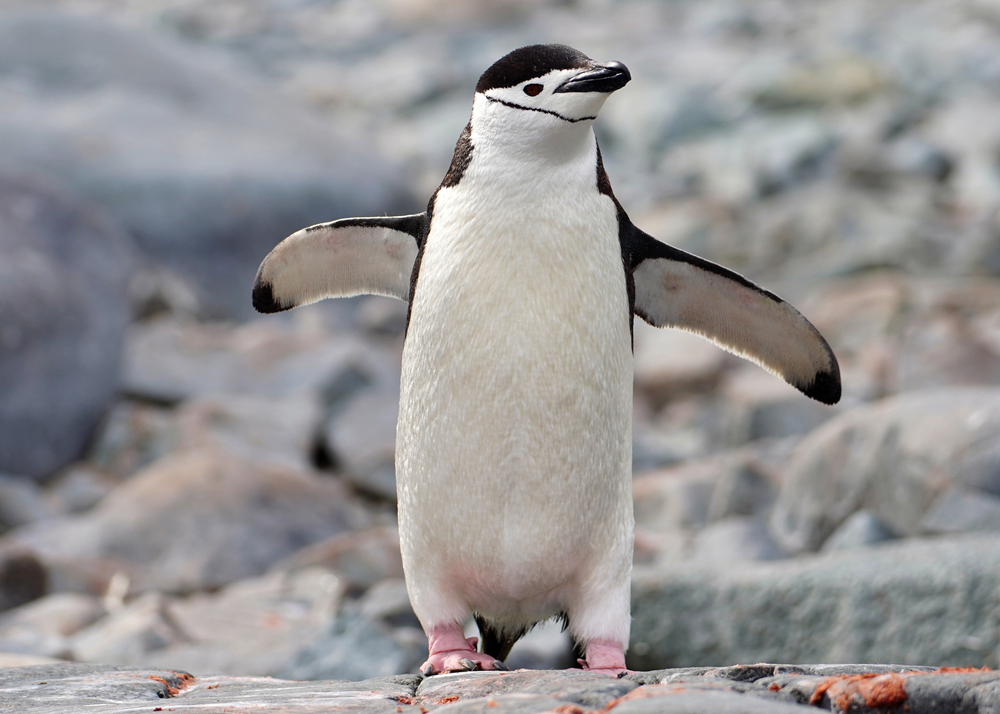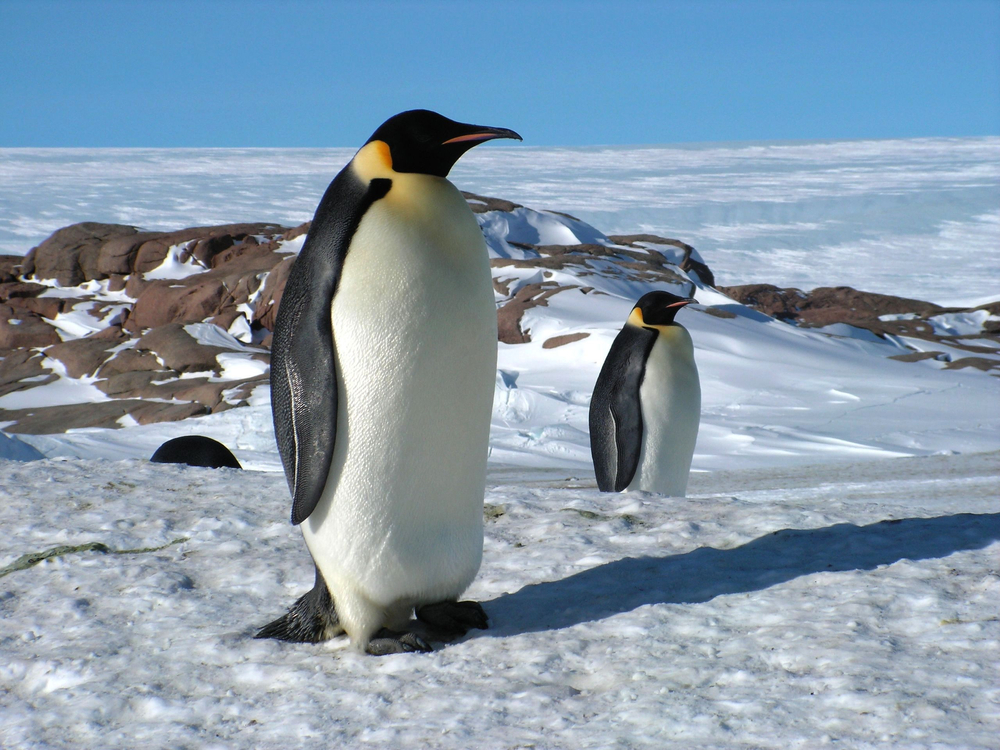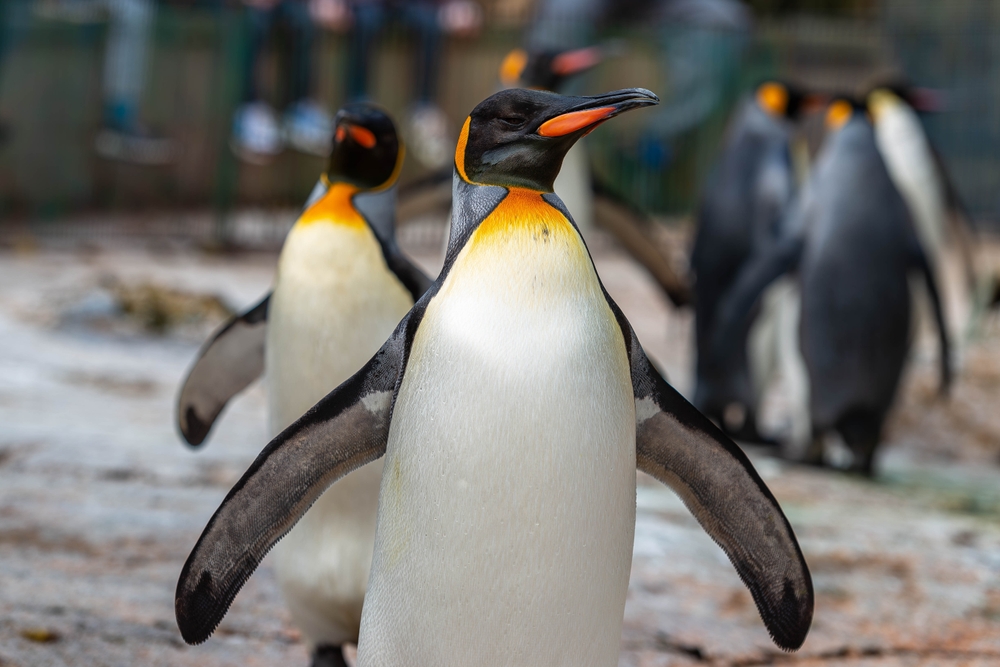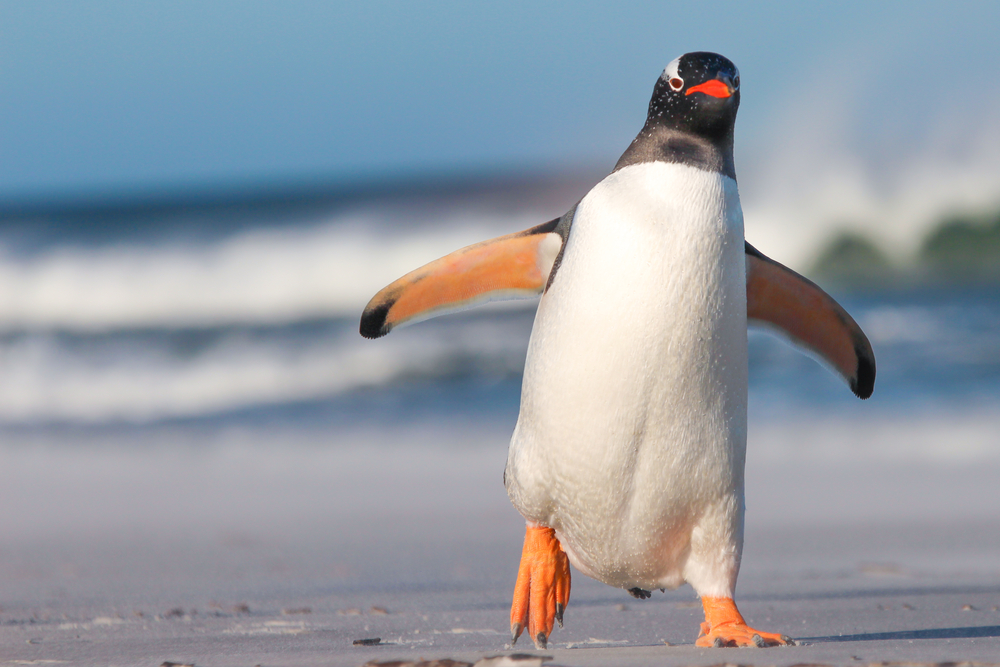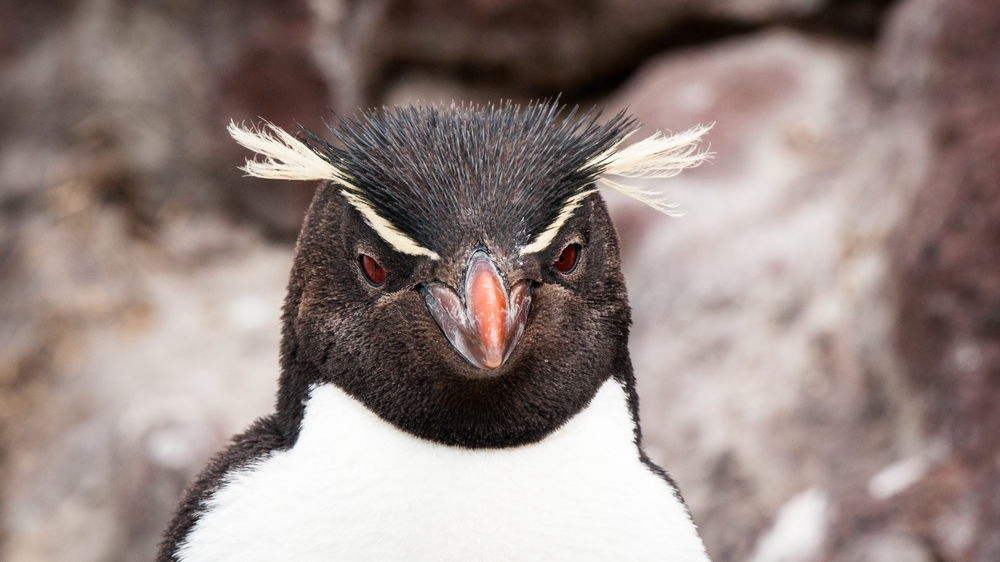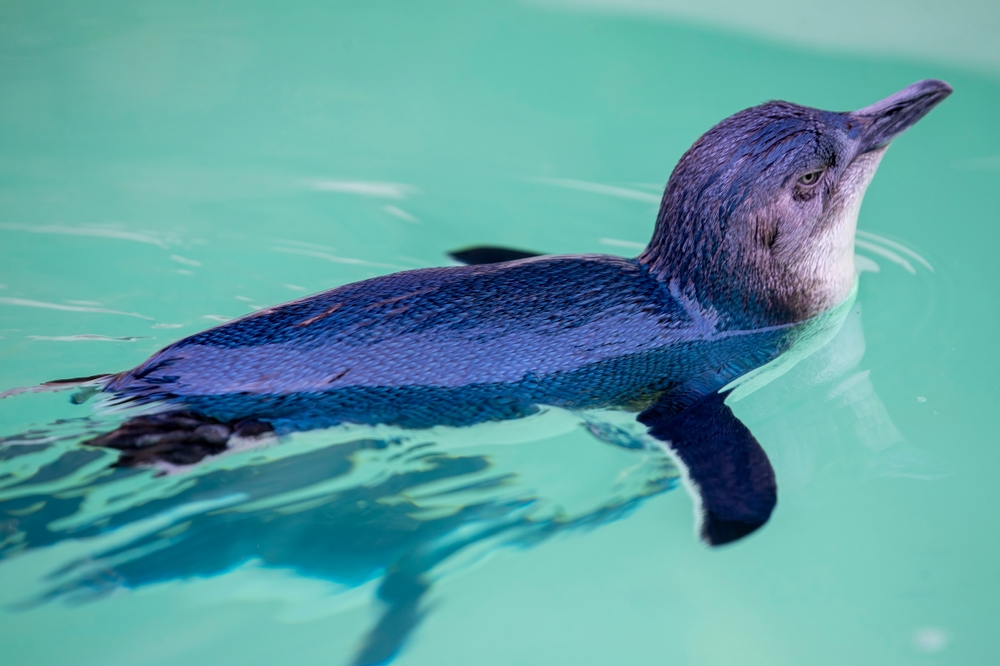The African Penguin’s closest relatives are the Humboldt Penguin, Magellanic Penguin, and Galápagos Penguin. Together, they form the Spheniscus genus, often called the “banded penguins” for their characteristic chest markings.
About
The African Penguin (Spheniscus demersus) is a medium-sized penguin of the Spheniscidae family, native to the southern coasts of Africa. Sometimes called the “jackass penguin” because of its donkey-like braying call, it is the only penguin species found naturally on the African continent. Its range extends along the coasts of South Africa and Namibia, where it inhabits offshore islands and some mainland beaches, most famously at Boulders Beach near Cape Town.
African Penguins stand about 60 to 70 centimeters (24 to 28 inches) tall and weigh between 2.2 and 3.5 kilograms (5 to 8 pounds). Their plumage features a black back and white underside with a distinctive horseshoe-shaped band of black across the chest and belly, as well as unique black facial markings. A pink gland above each eye helps them regulate body temperature by releasing excess heat.
Their diet consists mainly of small schooling fish such as sardines and anchovies, supplemented by squid and crustaceans. Agile swimmers, they can reach speeds of up to 20 km/h (12 mph) and dive to depths of over 100 meters (330 feet) while foraging.
Breeding occurs in burrows, under bushes, or in rock crevices to protect eggs and chicks from the harsh sun. Both parents share incubation and chick-rearing duties, raising one or two offspring per breeding season.
Unfortunately, the African Penguin is classified as Endangered, with populations declining due to overfishing, habitat loss, oil spills, and climate change affecting prey availability. Conservation programs, including artificial nesting sites, fishery management, and marine protected areas, are critical to its survival.
Known for its endearing calls and charismatic behavior, the African Penguin is a beloved symbol of South Africa’s wildlife and a key attraction for eco-tourism.
Physical Characteristics
African Penguins are medium-sized penguins native to the southern coast of Africa, easily recognized by their distinct markings and braying calls.
-
Coat/Plumage: They have black feathers on the back and face, with a white chest and belly. A distinctive black horseshoe-shaped band stretches across the chest and down the sides. Their plumage is dense and waterproof, insulating them in cold ocean waters.
-
Face: A prominent pink gland above each eye helps them regulate body temperature in hot climates. Their facial pattern includes a white stripe extending across the eye and throat.
-
Body: Compact and torpedo-shaped, streamlined for swift swimming. Their body design allows efficient diving and maneuvering underwater.
-
Flippers: Black above and white underneath, used like wings to propel them powerfully through the water.
-
Feet: Black and webbed, aiding both in swimming and clumsy walking on rocky shores.
-
Tail: Short and wedge-shaped, assisting in balance while moving across land.
Size:
-
Length (Body): Typically 24 to 28 in (60 to 70 cm).
-
Weight: Between 4.9 to 7.7 lbs (2.2 to 3.5 kg), with males slightly heavier than females.
African Penguins’ black-and-white coloring provides countershading camouflage: from above, their dark back blends with the ocean depths, and from below, their white belly blends with the lighter surface water. Their pink eye patches and chest band make them visually distinct from other penguin species.
Reproduction
The reproductive cycle of African Penguins is adapted to the warm, rocky coasts of southern Africa and its nearby islands.
-
Mating and Courtship:
-
African Penguins are monogamous and often return to the same mate each breeding season.
-
Courtship involves mutual preening, vocal braying calls, and bowing displays.
-
Breeding occurs throughout the year, though peak activity varies regionally.
-
-
Nesting:
-
They nest in burrows, under bushes, or in natural depressions to protect eggs from heat and predators.
-
Historically, penguins dug burrows in guano deposits, but widespread guano harvesting has forced many to nest on open ground, increasing vulnerability.
-
-
Egg Laying and Incubation:
-
Females usually lay two eggs per clutch.
-
Both parents share incubation duties equally, alternating shifts of about 1–3 days.
-
Incubation lasts 38 to 42 days.
-
-
Chick Development:
-
Chicks hatch covered in fluffy gray down and are brooded constantly for the first few weeks.
-
Both parents regurgitate partially digested fish to feed the chicks.
-
-
Fledging and Independence:
-
Chicks fledge at about 60 to 130 days, depending on food supply and colony conditions.
-
Once fledged, juveniles leave the colony to forage at sea, returning after 1–2 years when they reach sexual maturity.
-
African Penguins’ shared parental care and flexible breeding cycle help ensure higher chick survival rates in a challenging environment. However, food shortages, climate shifts, and habitat loss significantly impact their reproductive success.
Lifespan
African Penguins, sometimes called “jackass penguins” for their donkey-like bray, live along southern Africa’s coastlines and islands. Their lifespan varies depending on whether they are in the wild or under human care.
-
Lifespan in the Wild:
African Penguins typically live 10 to 15 years in their natural habitat. Survival is influenced by food availability, predation from gulls, seals, and sharks, as well as environmental changes and oil spills that threaten their coastal ecosystem. -
Lifespan in Captivity:
In well-managed zoos, aquariums, or rehabilitation centers, they often live longer due to regular feeding and veterinary care, sometimes reaching 20 years or more.
Threats to the African Penguin:
-
Food Scarcity: Declining fish populations (especially anchovies and sardines) due to overfishing and shifting ocean currents reduce their main food sources.
-
Climate Change: Rising sea temperatures affect fish distribution and breeding cycles, limiting penguin feeding success.
-
Habitat Loss: Historical guano harvesting destroyed natural burrowing sites, while coastal development continues to reduce safe nesting areas.
-
Oil Spills and Pollution: Oiling of feathers reduces waterproofing and insulation, often leading to hypothermia or drowning.
-
Predation: Eggs and chicks are preyed upon by kelp gulls, mongooses, and feral cats; adults face threats from Cape fur seals and sharks at sea.
Conservation programs—including marine protected areas, artificial nest projects, and rescue operations after oil spills—are critical for the survival of African Penguins, which are classified as Endangered by the IUCN.
Eating Habits
African Penguins are carnivorous seabirds whose diet is closely tied to the cold, nutrient-rich waters of the Benguela Current off southern Africa.
-
Diet:
Their primary prey includes small schooling fish, especially anchovies, sardines, and herrings. They also consume squid and crustaceans when available. -
Foraging Strategy:
African Penguins are pursuit divers, using their strong flippers to propel themselves underwater at speeds up to 12 mph (19 km/h). They typically hunt at depths of 30 to 130 ft (10 to 40 m) but can reach over 400 ft (120 m) when necessary. -
Hunting Behavior:
They often forage in groups, which helps herd fish schools into tighter clusters, making capture more efficient. Individual dives usually last 1 to 2 minutes. -
Feeding the Young:
Adults store food in their stomachs and regurgitate partially digested fish to feed chicks at the nest. During chick-rearing, both parents make frequent foraging trips to sustain rapid chick growth. -
Seasonal Variation:
Diet composition shifts with prey availability. Sardines and anchovies dominate during spawning seasons, while squid and other fish species supplement their diet at other times.
African Penguins’ dependence on sardine and anchovy stocks makes them highly vulnerable to overfishing and environmental shifts. Declines in fish populations directly impact chick survival and adult body condition, making fisheries management crucial to their long-term survival.
Uniqueness
The African Penguin (Spheniscus demersus) is a distinctive penguin species with several features that set it apart:
-
Only Penguin in Africa: It is the only penguin species that breeds on the African continent, confined to the coasts and offshore islands of South Africa and Namibia.
-
Pink Eye Glands: The bare pink patches above their eyes act as thermoregulation organs, helping them release excess body heat in warm climates.
-
“Jackass” Call: Their braying vocalizations resemble the sound of a donkey, earning them the nickname “jackass penguin.”
-
Distinctive Chest Band: A bold black horseshoe-shaped band across the chest and scattered black belly spots make each penguin’s markings unique, functioning like a fingerprint.
-
Burrow Nesters: Historically, they nested in guano burrows, which provided shade and protection, but guano harvesting forced many to use surface nests, increasing chick vulnerability.
-
Highly Endangered: Populations have plummeted by more than 60% in recent decades due to overfishing, habitat destruction, and oil spills, making them a focal point of conservation.
-
Indicator Species: Their dependence on sardine and anchovy stocks makes them a vital ecological indicator of ocean health along southern Africa’s coasts.
The African Penguin’s combination of hot-climate adaptations, unique vocalizations, and endangered status makes it one of the most recognizable and conservation-dependent penguin species in the world.
Be the First to Share Photos of This Species.
FAQ’s
1. What is the species closest to the African Penguin?
2. How does the African Penguin compare to other penguins?
African Penguins are smaller than Emperor or King Penguins but larger than the Little Blue Penguin. Unlike cold-climate penguins, they are adapted to warm, temperate environments, with pink eye patches that help regulate heat. Their braying calls and unique chest markings make them one of the most easily recognizable penguin species.
3. What national parks provide an opportunity to see the African Penguin?
African Penguins can be seen in South Africa’s protected coastal parks, including:
-
Table Mountain National Park (Boulders Beach) – home to a famous colony easily accessible to visitors.
-
Betty’s Bay (Stony Point Nature Reserve) – part of Kogelberg Biosphere Reserve.
-
De Hoop Nature Reserve – where penguins are sometimes observed offshore.
In Namibia, colonies are also found on offshore islands under marine protection. These parks and reserves offer the best chance to observe African Penguins in the wild.



































































